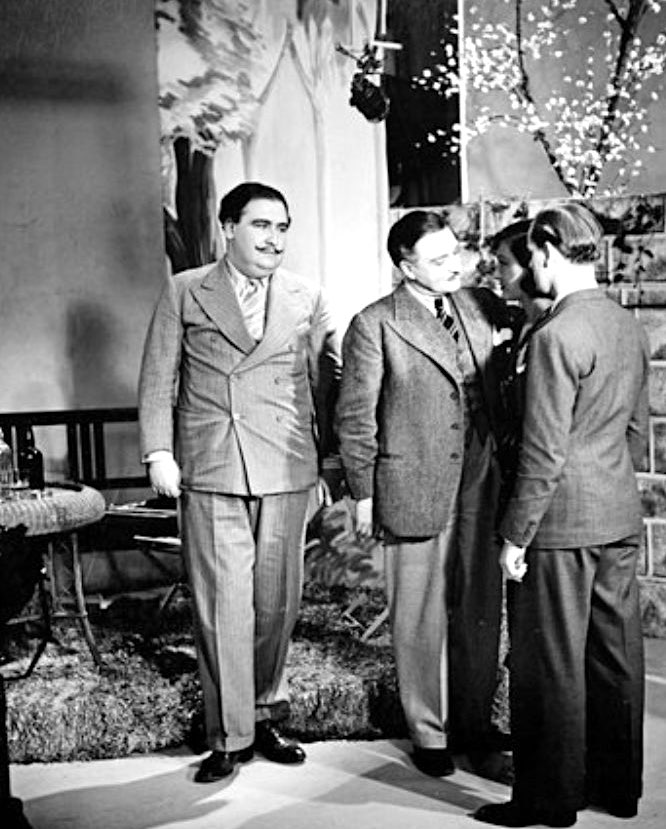OTD in early British television: 18 June 1937

John Wyver writes: The afternoon of Friday 18 June 1937 saw television’s first incarnation of Agatha Christie’s detective Hercule Poirot when George More O’Farrell staged her short play The Wasp’s Nest. Entrusted with the role of the Belgian sleuth was actor Francis L. Sullivan, described somewhat unflatteringly by Wikipedia as ‘a heavily built man with a striking double-chin and a deep voice.’
Sullivan had first played the character in Christie’s 1930 play Black Coffee. Again per Wikipedia, Sullivan
became a good friend of the author. She approved of his portrayal despite the fact that physically he was far too tall for the dapper little Belgian detective. (Sullivan stood six feet, two inches in height.)
He later played Poirot in the 1940 play Peril at End House and won a Tony award in 1950 for his appearance in Christie’s 1950 drama Witness for the Prosecution.
The play, which was presented again on the Friday evening, was adapted by Christie from her short story Wasps’ Nest which had first appeared in the Daily Mail on 20 November 1928; it was not anthologised until 1961 in the States and 1974 in Britain. As a television drama it is unique in being the only work that Christie herself adapted for the medium. Once more, we are indebted to Wikipedia for a synopsis of the story:
Poirot visits his friend John Harrison and tells him that he is in the locality to investigate a murder which has not yet been committed. He then turns the conversation round to a wasps’ nest on a tree that he sees nearby. A friend of Harrison, Claude Langton, plans to destroy the nest by using petrol injected by a garden syringe. Poirot asks, “Do you like Langton?” and they talk of Harrison’s engagement to a girl called Molly Deane who was previously engaged to Langton.
Poirot returns that evening to find Langton leaving and the nest still intact. Poirot tells Harrison that he traded the cyanide Harrison had in his pocket for some washing soda when he visited earlier on. Poirot witnessed the early signs of Langton’s romance with Molly Deane being rekindled and Harrison leaving a Harley Street consultant having obviously been given bad news. Harrison confirms that he has two months to live. Poirot surmised that Harrison was planning to commit suicide and make it appear that Langton had killed him, ensuring that his rival would be hanged for murder. Having realised and repented of what he would have done, Harrison expresses his gratitude for Poirot having visited and spoiled his plans.
The script was published by Samuel French, but of course no recording was made of the production. Mark Aldridge in his authoritative 2016 study Agatha Christie on Screen characterises the drama as
very well-plotted… but the dialogue and some of the character actions may have struggled to be wholly convincing.
The only known contemporary review was contributed by ‘E.H.R.’ for the Observer, who noted simply that it was ‘excellently done’.
Image: Francis L. Sullivan as Poirot, D.A. Clarke-Smith as Harborough, Antoinette Cellier as Nina and Wallace Douglas as Claude in The Wasp’s Nest.
[OTD post no. 183; part of a long-running series leading up to the publication of my book Magic Rays of Light: The Early Years of Television in Britain in January 2026.]
What’s emerging from your patient trawl of the Ally Pally schedule is how many top-flight people were ready to have a go at television – dancers, writers, actors. Seems it had some real cultural prestige, or was it just novelty?
Such an interesting question, Ian. I don’t think that television pre-war had significant cultural prestige (and arguably not for several decades after 1945), not least because the audience was tiny. But precisely because of that, and because the medium was greedy for material, and also was seen as marginal even within the BBC, it operated with few creative constraints.
Writers, dancers and others were attracted by the openness and the encouragement of innovation from producers like George More O’Farrell, Stephen Thomas and Dallas Bower. Plus, there were modest fees on offer, which is invariably an attraction for creatives.